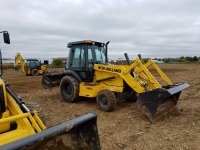TSO
Elite Member
Check out tractordata, industrial tractors. They list all the 545s. The very early models didn't use the torque convertor. All later models did. For your expected uses you might want to avoid the torque convertor if at all possible.
Yes thanks... I've seen that page (Tractor Data) so many times I've about memorized it LOL.
We use ours as a loader tractor, which is what it was designed to be used for. The electric shuttle is THE BEST thing about the tractor. I'll try to help any way I can, but I guess I would need to know more about what you want to do with the tractor. "Pulling a big mower" means different things to different people. I'd be thinking about a 20' bat wing. You won't have a good time with that either. LOL
As for what to look for...
The first thing that comes to mind is evidence of being greased / maintained. That tractor has a lot of grease fittings. Many are under the tractor. You may find fittings that the previous owner never greased because he didn't even know about them. The first ones that come to mind are the front axle pivot and the carrier bearing for the drive shaft going up to the front end. Don't forget the lower ball joints! The main bucket pins need extra grease, and rarely get it (you have to lift and rotate the bucket to get to them). We had to replace the universal joint that runs between the crankshaft and the front hydraulic pump right after buying ours. It was never greased and so badly worn that the yokes needed to be replaced as well. It is a pain to grease because you have to rotate the engine into just the right position to get the gun onto the fittings. We are going to need new steering cylinders before long. The ball joints are loose - again due to lack of grease. Those will be about $300 each, as the ball joints are part of the cylinders.
You are probably picking up on the pattern here: When taken care of, these tractors are exceptionally durable. We got ours pretty cheap, and we knew what we were getting. It took some time just to get all of the joints to take grease. $$$ wise, we haven't invested much at all in repairs compared to the use we have gotten out of the tractor. Actually, I'd rate our 345d as the best value of any of our equipment. It gets more hours each year than any of the other tractors. It's a fine machine.
Thanks... Those are all pretty much what i expected, the steering joints on my Ford 550 were well work out also. Good tip about the crankshaft pin, having to rotate the engine... That's a surprise that i wouldn't have had a clue about. Would you be able to draw an arrow for me so i can look to see where the access location is for it?
Regarding what I'll be doing with it... I love my Massey 1652. Great machine. I use it commercially for my landscape company, but use it less and less as i transition everything to SkidSteer work. I do rough and finish grading, seed and sod, and gravel work (driveways, private roads, etc). I also do land clearing and stumps. Also have lawn accounts (grass and field) and run a flail, but that's less and less as well.
However... I often need both a smaller tractor (mine is too big and heavy when driving over the finished surface to seed and straw, it leaves indents in the freshly graded ground) AND sometimes i need a larger tractor when doing gravel work, to pull the heavier implements and move material better, dirt work, and ripping stuff out with the loader. Stronger forklift ability would be helpful as well. I like that the 545D loader can keep up with, and exceed, the loader on my Track machine, which has a 5500 lb tipping load.
I can (and have been thinking about) sell my 3pt stump grinder and get a skid steer mounted one, so that doesn't necessarily have to be a deciding factor. BUT in case i need to use the tractor one still, i need the PTO option. When grinding, the tractor is stationary and the grinder is controlled hydraulically, so I'm thinking i can get by.
Finding a cheap smaller tractor with turf tires will be pretty easy.
Soooooooo... Mainly I'll be using this tractor for gravel work and some grading work, tree ripping (yanking out smaller trees under 6"), moving brush with a grapple, etc. In the winter it will get used for pushing and pulling snow. Occasionally, I'll need the PTO for flail mowing and stump grinding.

